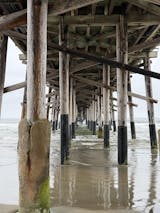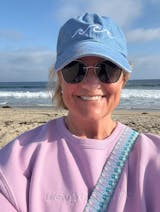Beachcombing Bay-cation on the Bay of Fundy
By Kirsti Scott

View from inside the St. Martins Sea Caves, Fundy-St. Martins (Karla Rodriguez Moran).
For thousands of years, people have lived along the ruggedly beautiful shores of the Bay of Fundy in New Brunswick, Canada. Originally home of the Wolastoqey, the Mi'Kmaq, and Peskotomuhkati Nations, the area around the mouth of the Saint John River was later settled by French colonists in the 17th century. In 1785, the city of Saint John became the first city incorporated in what is present-day Canada.

Regional map (Juan Alejandro Bernal/Shutterstock.com).
New Brunswick is still Canada’s only officially bilingual province, with both English and French widely spoken. The beauty and natural wonders still bring visitors to Saint John today. The area is 85% forested, with warm-water, sandy beaches on the west coast of the peninsula, and rocky beaches with sea cliffs, sea caves, fossils, driftwood, quartz, and sea glass on the Bay of Fundy to the east.

First Nations Storytellers (Envision Saint John). AREA 506 Waterfront Container Village (Envision Saint John).
While it is known as “Canada’s Oldest City,” Saint John is a mix of new and old, urban and untouched wilderness, and a diverse mix of inhabitants and visitors. The city is a destination for cruise ships, and a lively arts scene, walkable downtown, historic architecture, and more greet visitors coming by land or sea. Take a guided walk with First Nations Storytellers that lets you connect with nature, culture, and history through an Indigenous point of view. The AREA 506 Waterfront Container Village next to the cruise port is a collection of shops, restaurants, and a performance space housed in colorful shipping containers, many painted by artists. Saint John’s uptown is a vibrant, walkable historic area of the city, with restaurants, galleries, and 100 years of architectural styles.

Saint John City Market (Envision Saint John). Saint John City Market stall (Phyllis Ford). 506 Waterfront Container Village and artist painting (Envision Saint John)
The indoor Saint John City Market, the oldest continuing farmers market in Canada, features vendors selling fresh produce, handmade arts and crafts, and plenty of delicious foods, housed in a 19th-century building designated as a National Historic Site of Canada.

Saint John City Market watercolor artist, glass floats (Scott Munn). Uptown art gallery (Envision Saint John).
Toward the waterfront from the Market, the Ihtoli-Maqahamok, which translates to “The Gathering Space” in the local Mi’Kmaq language, is a public space with restaurants, performance spaces, and steps leading down to the Bay of Fundy. Beachcombers can go beachcombing in Saint John, plus take day trips to the surrounding communities to really explore various beaches of the Bay of Fundy.

Reversing Falls, Saint John (Brian Atkinson).
The Bay of Fundy experiences the world’s highest tides, which not only make the Saint John River appear to run in reverse at times, but also means the waves regularly wash in new sea glass, seashell, and rock finds. “In Saint John, we have a 28-foot height difference between low and high tide, and this occurs in a roughly six-hour window,” says Jen Silliphant of Envision Saint John. “A full tide cycle, from high tide to high tide, takes almost 12.5 hours. Not only does this mean that beachcombers need to be aware of the tides, but it also means that the beaches are always changing, thanks to this constant flow of water.”

A successful day at the beach (Karla Rodriguez Moran).
Karla Rodriguez Moran is a beachcomber in Saint John and the organizer of the Saint John Seaglass Festival, celebrating its fourth year in 2025. Originally from El Salvador, Karla has been collecting sea glass since she moved to Saint John six years ago, going beachcombing almost every day. Her favorite finds are her first marble, lavender sea glass, and a large piece of red sea glass, a very rare find in this area. “My daughter teased that our house is like a sea glass museum,” Karla says. So now she has limited her collection to one room in her office, plus she makes art and jewelry with some of her pieces.

Sea glass and seashell finds (Karla Rodriguez Moran).
“My favorite time to go beachcombing is early in the morning—however you have to be aware of the tides, as well,” Karla says. One time, she wasn’t paying attention to the tides, and she got stuck. “I had to swim to shore, in my clothes, shoes and all.” Be sure to check the tides on the Canadian Government Tidal and water level stations website at www.tides.gc.ca/en/stations. Just search for Saint John (or the name of the beach you are visiting) to make sure you will be able to get back from the beach safely.
Karla has some favorite beaches along the Bay. Most beaches you can drive or walk to and then explore on foot. “The Bay of Fundy Coast is truly a fantastic place to beachcomb, and Saint John is located right in the middle of it,” says Karla. “The Mispec Beach/Anthony’s Cove area on the city’s east side, as well as the beaches surrounding it, are great spots to find sea glass in the city. The beach next to the Digby Ferry, Bayshore Beach, is also a fantastic place to find unique pieces. The Digby Ferry terminal location was used as the dump years ago in Saint John, so a lot of trash has been washed out to sea and then is showing back up on beaches.” Karla also recommends Tin Can Beach.

Sunset at the beach (Karla Rodriguez Moran). St. Martins Sea Caves, Fundy-St. Martins (Karla Rodriguez Moran).
Just a 45-minute drive outside of Saint John, Fundy-St. Martins and Blacks Harbour are good beaches to comb. “Blacks Harbour beach, where the ferry terminal is located, is a fantastic beach for sea glass and pottery,” Karla says.
“At Fundy St. Martins, you can walk on the ocean floor at low tide and kayak the same area at high tide, exploring ancient red sandstone sea caves carved by the Bay of Fundy tides,” says Jen. The village of St. Martins has shops, cafés, and restaurants, plus picturesque, covered bridges. “You can also visit the Fundy Trail Provincial Park, one of the last remaining coastal wilderness areas between Labrador and Florida.”
Karla adds, “Driving a little further, Grand Manan Island, Deer Island, Campobello Island, and Cape Enrage are amazing day trips along the Bay of Fundy and they all have beautiful, rugged beaches full of sea glass and other beachcombing finds. Cape Enrage is a trip back in time as the beach there is loaded with fossils that are more than 300 million years old.”
While Karla’s favorite finds are sea glass in all colors, she also collects colored quartz stones and driftwood. “Seashells are very rare, but we have some beautiful, colored shells,” Karla says. “Glass bottle stoppers and sea pottery are also rare but great finds, as well as tons of ‘pirate sea glass,’ which appears black, but under a light is any other number of colors (red, yellow, purple, etc.). Those new to beachcombing might miss it, thinking it’s a rock, but they’re quite beautiful.” Karla also finds lots of blue and white china, remnants from Saint John’s historical connections to England.
At the northern end of the Bay of Fundy, you can visit Hopewell Rocks Provincial Park, where the changing tides have sculpted dozens of free-standing sea stacks along the shoreline. Be sure to check tide times to find the best time to walk the ocean floor under these otherworldly formations.
Jen says the area has every type of beach, including very rocky places, sandy places, sea cliffs, sea caves, and more. “We have lots of uncrowded beaches where you can enjoy nature and listen to the silence,” Jen says. “New Brunswick has 450 species of birds, including many seabirds. In many cases, the only sounds you hear are the waves lapping on shore and the chirping of birds.”
Saint John has a temperate climate, which is always affected by its proximity to the Bay of Fundy. “The trick to being on the Bay of Fundy is to wear layers—you never know how much the temperature will change as you travel along the coast,” says Jen.

Saint John Seaglass Festival (Karla Rodriguez Moran).
If you time your visit for the end of August, don’t miss the Saint John Seaglass Festival. Scheduled for August 29–30, 2025, in the Market Square building in the heart of uptown Saint John, this event features over 50 vendors selling sea glass jewelry, sea glass trees, ornaments, driftwood art, handpicked sea glass, and coastal art and décor. There are speakers, live music, and plenty of beachcombers of all ages enjoying the festival.
After your day at the festival or beach, Jen recommends you grab an ice cream at Bella’s Traditional Ice Cream, a lobster roll at Spinney’s, and a beer (and brewery tour) at Moosehead Brewery.
Saint John is a 75-minute drive from the U.S. border at Calais, Maine; a 5-hour drive from Portland, Maine; or a 7-hour drive from Boston, Massachusetts. From Nova Scotia, it’s a 2-1/2-hour ferry crossing from Digby or a 4-hour drive from Halifax. You can catch flights from Montreal and Toronto or a cruise from Boston, New York, or New Jersey. Beachcombers will want to have a car if they’re planning to visit the beaches along the Bay of Fundy coast.
Follow Saint John Seaglass Festival on Facebook @saintjohnseaglassfestival. Plan your trip to Saint John and New Brunswick at www.discoversaintjohn.com and tourismnewbrunswick.ca.
Learn more about the best beaches and destinations for sea and beach glass, seashells, fossils, rocks, and more beach finds around the world. Articles ›
This article appeared in Beachcombing Magazine Volume 49 July/August 2025.









